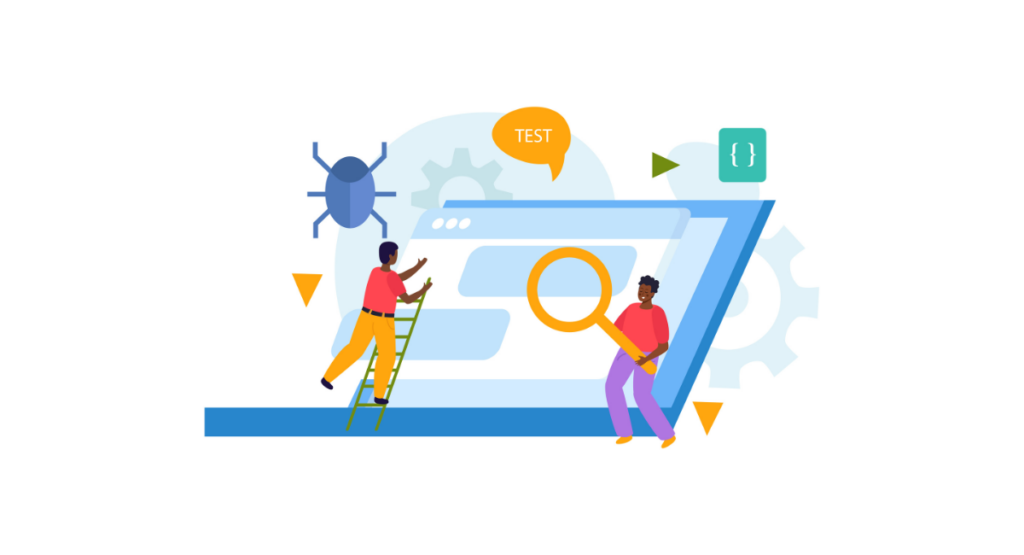Moreover, it has to be further supported that E2E testing guarantees the quality and functionality of any software developed from scratch. Also, it emulates scenarios and user interactions with the software in reality, so this places it in a very integral position during development.
The more complex the software, then, the greater the need to build E2E tests that are not only effective but also readable, stable, and maintainable.
This blog will give insights into the best practices of how to craft an E2E testing framework that developers and QA teams could count on to get great software products that stand the test of time.
Importance of E2E Testing

End-to-end testing is one of the important methodologies in software engineering, where real-world user behavior and environments have to be imitated to validate complete system functions.
Contrasted with unit integration testing, it covers E2E from frontend to backend, data layers, and external dependencies. This is of great value because it ensures that all subsystems work in concert under various types of scenarios and thus makes it possible to identify problems that may appear only when a user interacts with an application.
E2E testing confirms that the integrated parts of an application work expectedly and interact correctly with other systems and peripherals. It is a critical part of ensuring that the product developed by the organization is of high quality.
It mainly contributes to the verification of business logic, data integrity, and performance benchmarks, all of which work in conjunction to make the application stable and rugged.
Readability in E2E Testing
Readability is very important in E2E testing. More readable scripts are easier to read, understand, modify, and debug.
Looking at the fact that software systems are growing in complexity, it's pretty easy to maintain readability within test scripts such that developers and testers have no headache once they want to analyze exactly what every part of the test is intended to do.
And it doesn't just bring speed in development but also enhances collaboration among team members who might have completely different technical backgrounds.
Benefits of Readable Testing Scripts
Readable E2E testing scripts offer several advantages:
- Enhanced collaboration: Clearly written tests can be easily understood by all team members, regardless of their role within the team. This understanding is crucial when tests fail and developers need to diagnose and resolve issues quickly.
- Ease of maintenance: Tests that are easy to read are simpler to update and maintain. As the application evolves, the associated test scripts must also be revised. Readability reduces the effort required to make these revisions correctly.
- Improved efficiency: Readable scripts streamline the review and debugging processes. Developers spend less time figuring out what the test does and more time on how to fix or improve the actual code.
- Better onboarding: New team members can quicker get up to speed with the existing codebase and testing environment if the test descriptions are clear and straightforward.
Tips for Improving Readability
Enhancing the readability of your E2E testing scripts involves several practical steps:
- Use descriptive names for test cases: Choose names that clearly describe what the test is checking. Avoid vague names and acronyms which can confuse new developers or testers.
- Implement comments and documentation: While over-commenting can clutter your code, strategically placed comments can elucidate complex logic or important reasons behind specific test steps.
- Adopt a consistent style: Consistency in coding practices, such as formatting, naming conventions, and structure, can dramatically improve the legibility of your test scripts.
- Utilize data-driven tests: These allow you to separate test logic from test data, making the scripts less cumbersome and easier to understand. Plus, it can simplify the process of updating tests when your data changes without altering the logic of your tests.
- Regularly refactor tests: As with production code, refactoring test code is vital. Simplifying and cleaning tests regularly can prevent them from becoming bloated and difficult to manage over time.
By focusing on readability, your E2E tests become more than just code; they turn into valuable documents that contribute substantially to the understanding and improving of your application.
Stability in E2E Testing

Importance of Stable Testing Frameworks
Stable testing frameworks are fundamental in E2E testing to ensure that every component of an application interacts correctly over various environments and updates.
Stability primarily prevents false positives and negatives, which can be costly in terms of both time and resources. A stable test setup gives confidence to stakeholders that the product runs as expected, reducing the risk of unpleasant surprises during production releases.
Moreover, it ensures that test results are reliable and consistent, critical for continuous development and deployment cycles.
Techniques for Ensuring Stability
To achieve stability in E2E testing, several practical techniques can be employed:
- Consistent Test Environment: Use containerization tools like Docker to keep your testing environment consistent and isolated from external changes.
- Dynamic Data Management: Implement strategies for handling test data dynamically to avoid failures due to data state changes. This includes using data pools, factories, and cleanup mechanisms.
- Proper Synchronization: Address race conditions and synchronization issues by waiting for elements to load or states to change before actions are performed.
- Flakiness Identification: Regularly run tests at different times to identify and fix any flaky tests those that exhibit erratic behavior across multiple executions.
- Error Handling: Implement robust error-handing and recovery strategies to manage exceptions gracefully and maintain the flow of tests.
Maintainability in E2E Testing
Significance of Maintaining Testing Scripts
Maintaining testing scripts is crucial to scaling and adapting tests over time as applications evolve. Well-maintained scripts help in reducing the technical debt that usually accumulates with quick patches and fixes.
Proper maintenance ensures that tests remain relevant, accurate, and efficient, providing value in tracking regressions and validating new features swiftly and effectively.
Strategies for Enhancing Maintainability
To enhance maintainability, adopt these strategies:
- Modular Design: Write tests in smaller, reusable modules or functions that can be easily updated or replaced.
- Version Control: Use a robust version control system to track changes in test scripts, enabling easier rollbacks and understanding of history.
- Documentation: Document test cases and their purpose comprehensively. This helps new developers and testers understand and modify tests without a steep learning curve.
- Code Review: Regularly have peers review test code to ensure it adheres to best practices and is as clean and efficient as possible.
- Continuous Refactoring: Periodically refactor tests to improve clarity, efficiency, and effectiveness. This involves removing redundancy, improving naming conventions, and updating outdated methodologies.
Implementing these strategies forms the backbone of a resilient end-to-end testing framework, driving high-quality software development with confidence in product stability and maintainability.
Best Practices for E2E Testing
E2E (End-to-End) testing is a critical aspect of the software development lifecycle, aimed at ensuring the integrity and reliability of software applications from start to finish. To achieve effective E2E testing, adherence to best practices is paramount.
Integration of Readability, Stability, and Maintainability
Integrating readability, stability, and maintainability into your E2E testing strategy enhances the effectiveness and lifespan of test scripts.
Readability ensures that tests are understandable by different stakeholders, and even those who may join the project at a later stage. To improve readability:
- Use clear and descriptive naming for test cases and variables.
- Implement comments and documentation within the test code.
Stability in E2E testing involves creating tests that consistently return the same results under similar conditions. To achieve this:
- Minimize dependencies between tests to reduce flakiness.
- Employ retry mechanisms for handling transient issues.
Lastly, maintainability can be addressed by:
- Regularly refactoring tests to improve efficiency and remove redundant codes.
- Using version control systems to manage changes and collaborations effectively.
Automation Tools and Technologies
The choice of the correct tools or technologies is one of the most important parameters in E2E testing frameworks. Keeping in mind the nature of integration with the development environment, use for the test cases, ease of use, and many other things are significantly important.
Among the E2E testing tools, such examples include Selenium, Cypress, and TestCafe. Some have their propriety strengths, most famous for which is Selenium in cross-browser compatibility and flexibility.
- Cypress provides real-time reloads and auto-waiting.
- TestCafe doesn't require any WebDriver; tests are executed directly in the browser. It makes setup easier and speeds up test execution time.
Two other things which will make the testing process even more automatic are to include continuous integration/continuous deployment tools like Jenkins or CircleCI, and run tests automatically every time changes are committed to the code.
Continuous Improvement in Testing Frameworks
Testing frameworks for E2E need constant improvement in their efficiency. This involves:
- Frequently updating the testing tools and libraries underpinning them, so that the latest features and security updates are infused.
- Root cause analysis of the recurring failures within the tests and addressing them to improve test accuracy and reliability.
- Encourage feedback from users of the testing frameworks that point to areas needing enhancement.
Secondly, focused improvements can be guided by implementing metrics and KPIs measurement for testing-process performance. This will guide the overall robustness and efficiency of your E2B testing framework over time.
Book a Demo and experience ContextQA testing tool in action with a complimentary, no-obligation session tailored to your business needs.
Conclusion
As we've explored, establishing a great E2E testing framework significantly contributes to the overall quality and reliability of software products.
By focusing on creating tests that are readable, stable, and maintainable, teams can ensure that their testing processes are both efficient and effective.
Remember, readability enhances collaboration among stakeholders, stability ensures consistent test results, and maintainability allows easy updates and scalability of test scripts.
With these principles in mind, your E2E testing framework will not only serve its immediate purpose but also adapt to the future needs of your projects, ensuring long-term success and reliability.
Also Read - How to Write a Winning QA Resume: A Complete Guide for Quality Assurance Professionals
We make it easy to get started with the ContextQA tool: Start Free Trial.
